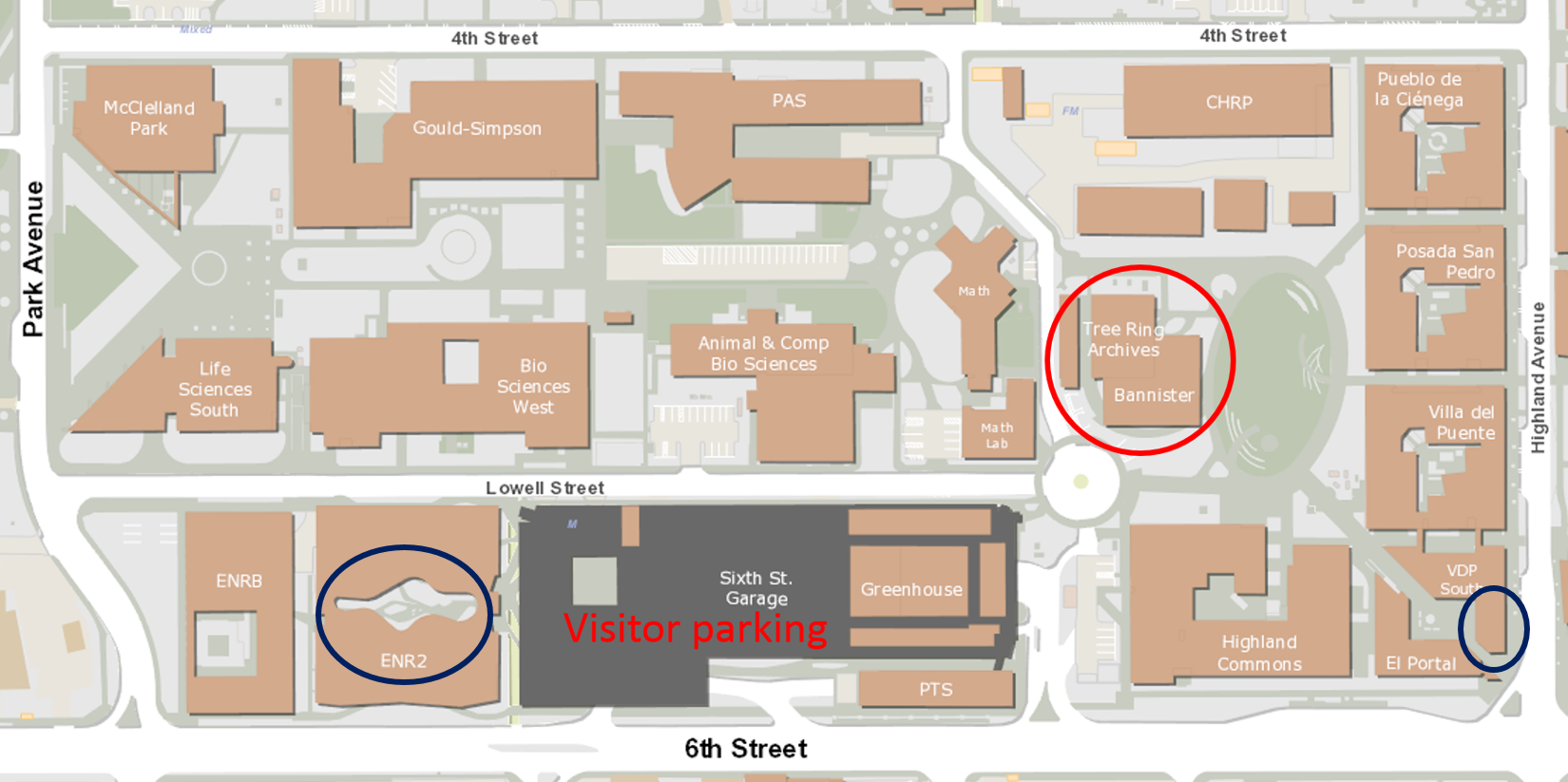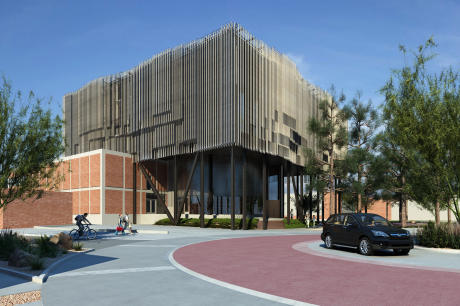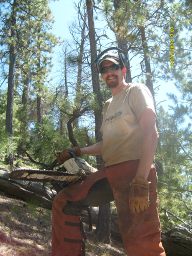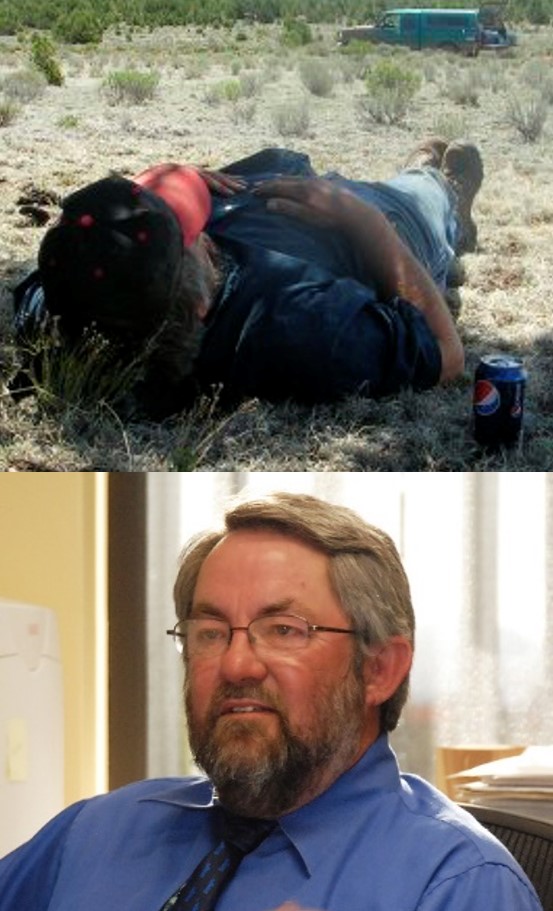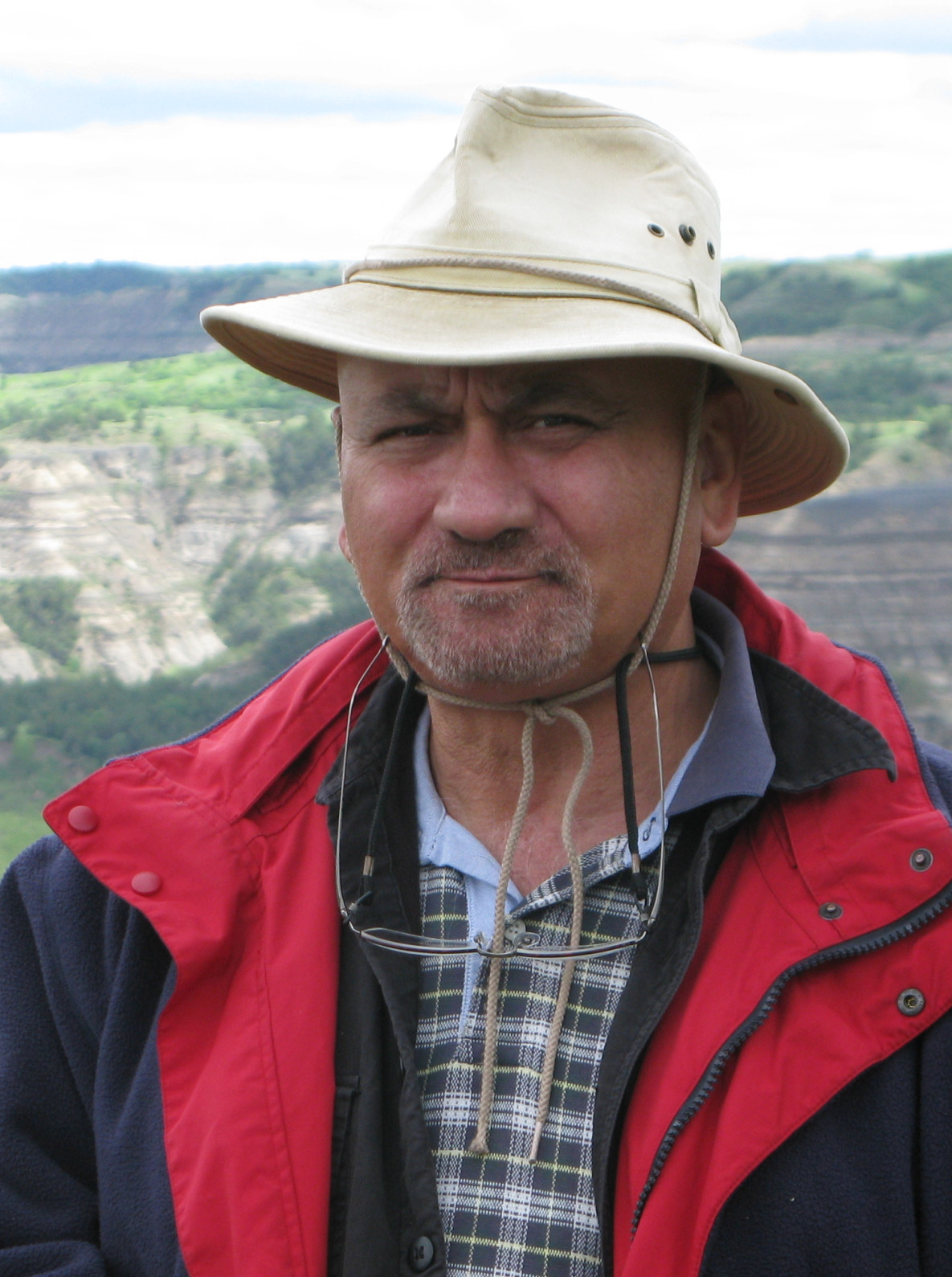

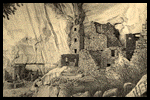
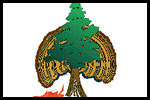
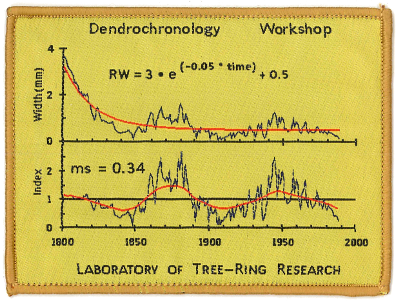
University of Arizona
Laboratory of Tree-Ring Research
2017 Summer Presession Courses
in
Dendrochronology
May 15 — June 2, 2017
Map of LTRR
(click to see larger image)
Historical concept of LTRR
(click to see larger image)
Course Objectives
The objectives of the Summer Presession Courses in Dendrochronology include:
- Cover basic background of dendrochronology, the study of tree rings
- Practice the accurate dating of the year of formation of tree rings, using multiple techniques
- Understand features of tree rings that can be measured and used to assess/reconstruct environmental signals and/or to date events of the past
- Learn by experience aspects of fieldwork in dendrochronology, including recording field notes electronically
- Additionally in the field, visit and see first-hand the iconic sites of the Grand Canyon, Sunset Crater, Wupatki, and Montezuma Castle and Well, and learn of their historical significance in the science of dendrochronology
- Learn by experience wood shop techniques of preparing dendrochronological specimens for analysis
- Learn by experience the measurement of ring width and data management and sharing
- Learn by experience the use of specialty software for analyzing tree-ring data
- Synthesize replicated dendrochronological data into a defensible interpretation
- Make short, formal presentations of results to a general audience
- Specialize in a specific subdiscipline of dendrochronology:
- Archaeology: Dating of past events of human origin, as well interpreting those events in climatological/ecological contexts
- Climatology: Modeling modern tree-ring patterns with meteorological data and then reconstructing climatic variability of the past, as well as interpreting high- and low-frequency temporal variability in archaeological/ecological contexts
- Ecology: Discerning non-climatic signals in tree-ring series that might be ascribable to ecological processes such as fire, insect outbreaks, hillslope positioning, and/or forest management treatments, as well as interpreting ecological events of the past in archaeological/climatological contexts
Other Lecturers
Teaching Assistants
and Administration
- Dr. Dave Meko
- Dr. David Frank
- Dr. Malcolm Hughes
- Dr. Steve Leavitt
- Dr. Ann Lynch
- Dr. Margaret Evans
- Dr. Tomasz Wazny
- Dr. Jeff Dean
- Dr. Don Falk
- Dr. Erica Bigio
- Dr. Chris Guiterman
- Dr. Soumaya Belmecheri
- Dr. Irina Panuyskina
- Dr. Bethany Coulthard
- Mr. Kai Lepley
- Dr. Martin Munro (the LTRR IT guy)
- Dr. Pete Fulé, NAU Forestry
- Ms. Cheryl Miller, NAU Centennial Forest
- Ms. Amanda Grady, USFS Forest Health Protection
- Ms. Rebecca Renteria
- Mr. Alex Arizpe
- Mr. James Wilcox
- Ms. Marianne Hamilton
What to Bring for Tucson and for Fieldwork
Tucson: Mid May and early June will be hot during the day and mildly warm at night. Click here for local weather, then click on Tucson on the map for 5-day forecast. Note: The LTRR classroom is often kept cooler than preferred, so perhaps bring a sweater to class each day while in Tucson. Tucson after hours:
- Academic casual attire will suffice for most activities.
- Hat and sunglasses highly recommendable.
- Sunscreen also a good idea for outdoor activities lasting more than an hour.
- Personal laptop:
- Martin (LTRR IT) has provided instructions on Wifi access while here.
- For PCs and Java applets: It's looking like Internet Explorer (IE) is the last browser left still running Java applets, e.g., our applet tool for teaching online how to crossdate by skeleton plotting. Neither Chrome nor Firefox supports applets anymore. Unfortunately, IE runs only on PCs (not Macs). If your laptop is a PC, please have IE installed as a browser, and follow these instructions to enable Java applets:
- Click Tools and then Internet Options
- Select the Security tab, and select the Custom Level button
- Scroll down to Scripting of Java applets (almost the very bottom)
- Make sure the Enable radio button is checked
- Click OK to save your preference
- For Macs and Java applets: On recent Macs, Java is not pre-installed or available through Apple, but Java can be downloaded in the usual way from here (the link to do this is clearly displayed on the main page there). Once installed, the built-in web browser on Mac OS, Safari, should be able to run the applet, but, as usual, various security warnings and must be selected to proceed before the applet will appear for the first time. Older Macs had a version of Java provided through the system, but Apple stopped supporting that a while ago.
- PC vs Mac: DPL software runs for sure on PCs, and probably also on Macs after some work-arounds.
- Don't forget a thumb drive for easy copying, storing, and sharing of data files.
Fieldwork: Northern Arizona and New Mexico will be cooler, with at least some chance of rain.
- Things to do around campus, the Main Gate
- Things to do downtown (get there by the streetcar)
- Downtown restaurants
- Restaurant & bar guide (pdf file)
Overnight accommodations in the field:
- Long clothing (pants and shirt) required for field days
- Hiking boots required for field days (lighter shoes ok for evening)
- Hat, sunglasses, and sunscreen essential, maybe a bandana also
- Cold weather clothing (jacket, gloves, balaclava, raingear), just in case
- Small daypack
- Personal water bottles, travel mugs
- Personal GPS units desired (but not required)
- Personal increment borer, if you have one
- Gloves for coring, as preferred
- Personal Android device, if you have one
- Personal medications (personal medical issues?)
- If you have a serious medical condition that requires daily medication, you must (a) inform the instructor in advance of the field trip, and (b) bring at least a 1 week supply of the medication
- Personal first-aid kit, as desired
- Insects are not usually a problem in high country of New Mexico and Arizona in late spring. Perhaps the occasional mosquitos at dusk, but ticks are not as bad here as in other places of the US. Long clothes help ward off insects. Still, feel free to bring repellent as desired.
- All: Fieldtrip lodging and food expenses will be covered by the Presession fees.
- Archaeology: Camping gear will be needed for part of this trip, though you'll be at the Merriam-Powell Research Station of Flagstaff for May 23 & 24.
- Climatology: Motel rooms are reserved for this trip.
- Ecology: The Ecology class will stay at the Merriam-Powell Research Station of Flagstaff. This station has bunk rooms (pillow and a light blanket are provided, but not linens), showers (bring your own towel), a kitchen, and group amenities. If you have a sleeping bag and can conveniently bring it, please do so. Food and meal planning for this fieldweek will be discussed in class, Friday, May 19.
Tuesday, May 16 Time Archaeology Climatology Ecology 8:30-9:30 Lecture: Tree-ring dating: what is it, how is it done? (visual dating, measurement matching) (Ron Towner)
Douglass 1941: Crossdating (a classic)
Slides for this lecture9:45-10:45 Lecture: Tree-ring characteristics that can be measured: TRW, EW, LW, false banding, density, resin ducts (Malcolm Hughes, confirmed)
Vaganov et al.: Tree-ring structure in conifers
Malcolm's powerpoint slides11:00-12:00 Lecture: History of Dendroarchaeology (Ron Towner, classroom)
Slides for this lectureLecture: Dendrodemography (Margaret Evans, confirmed, conference room)
Macalady & Bugmann: Predicting tree mortality
Iniguez et al.: Historical forest age structure
Biondi: Tree-rings vs forest inventories, Gus Pearson Forest
Slides for this lecture12:00-1:00 Break for lunch 1:00-2:00 Lab: Crossdating exercises (in classroom) Lab: Crossdating by Yamaguchi character list technique (Paul Sheppard, in conference room)
Yamaguchi: Character list crossdating
Speer: List method
Representative data form for character list technique2:00-4:30 Lab: Continue Crossdating of Zuni Mt. specimens (Jesse Minor et al.) 4:30-5:00 A few student presentations: background and research (bring a powerpoint with a few slides, e.g., a map, a couple field shots, research objectives), and expect to fill ~5 minutes of presentation time. Everyone participates.
Wednesday, May 17
Climatology leaves for the field, 8:00 AM departure time, arrive to Sunset Crater by midday
Lecture in the field: Site & tree selection, sampling strategies, field techniques
Grissino-Mayer: Species used in dendrochronologyTime Archaeology Ecology 8:30-9:30 Lecture: Principles: limiting factors & ecological amplitude (Ron Towner)
Fritts et al.: Tree rings along a vegetational gradient
9:45-10:45 Lecture: Principles: site & tree selection (Don Falk confirmed)
Grissino-Mayer: Species used in dendrochronology11:00-12:00 Lecture: Principles: uniformitarianism (but, age effects & divergence) & linear aggregate model (Paul Sheppard)
Speer: Uniformitarianism
Szeicz & MacDonald: Age-dependent dendroclimate modeling
D'Arrigo et al.: Divergence
Cook: Linear aggregate model12:00-1:00 Break for lunch 1:00-2:00 Lab: Crossdating exercises (in classroom) Lab: Crossdating with BAR plots and ITRDB chronologies (Paul Sheppard, in conference room)
Grissino-Mayer & Fritts: ITRDB
International Tree-Ring data Bank
A representative BAR plot2:00-4:30 Lab: Continue crossdating of Zuni Mt. specimens (Jesse Minor et al.) 4:30-5:00 A few student presentations: background and research (bring a powerpoint with a few slides, e.g., a map, a couple field shots, research objectives), and expect to fill ~5 minutes of presentation time. Everyone participates.
Thursday, May 18
Climatology in the field: continued sampling, then return to Tucson late afternoon
Time Archaeology Ecology 8:30-9:30 Lecture: Mediterranean dendroarchaeology (Tomasz Wazny, confirmed, conference room)
Guidelines on dendro dating
Wazny: Secrets of a Rembrandt School still life
Wazny: Tibetan books
Lecture: Open Data Kit (ODK) theory & basics
(Chris Guiterman, confirmed, classroom)
OKD instructions for presession
Brewer-Guiterman: ODK fieldwork9:45-10:45 Lecure: Dendroarchaeology and human behavior (Jeff Dean, confirmed, conference room)
Dean: Behavioral error in archaeological tree-ring datingField: ODK field practice on Highland Bowl Forest, including uploading data
(Chris Guiterman et al., confirmed, classroom)11:00-12:00 Lecture: Cambium peeled trees in the Zuni Mountains (Ron Towner, conference room)
Towner & Galassini: Peeled trees of the Zuni MountainsLecture: Introduction to quantitative dendro analysis using R (Margaret Evans, confirmed, classroom)
R project website
R studio website
dplR website
Bunn: dplR
Bunn: Intro to dplR12:00-1:00 Break for lunch 1:00-2:00 Lab: Continue crossdating of Zuni Mt. specimens (Jesse Minor et al.) 2:00-4:30 4:30-5:00 A few student presentations: background and research (bring a powerpoint with a few slides, e.g., a map, a couple field shots, research objectives), and expect to fill ~5 minutes of presentation time. Everyone participates.
Friday, May 19 Time Archaeology Climatology Ecology 8:30-9:30 Lecture: Basics of dendroarchaeology (Ron Towner)
Nash: Time for collaboration, dendroarchaeology of the American Southwest
Towner: Archaeological dendrochronology of the Southwestern US9:45-10:45 Lecture: Basics of dendroecology (Don Falk)
Slides for this lecture11:00-12:00 Tour: Labs of the Tree-Ring Building (Pamela Pelletier, confirmed) 12:00-1:00 Break for lunch 1:00-2:00 Demonstration: Tellervo, in room 414 (Erica Bigio, confirmed)
Brewer: Tellervo
Tellervo download & access instructions2:00-4:30 Lab: Continue dating Zuni Mountain specimens (classroom) Lab: Crossdating of San Pedro Mártir specimens (classroom) Plan the menu for upcoming field week (conference room)
Important: Archaeology and Ecology: For Tuesday dinner (May 23), download this menu and fill it in (add your name to it and circle two entree items you'd like, see Paul's as an example). Add other food restrictions as necessary. Then save your file with your name added to the filename and upload it to our Box space into a folder name Kacina menus. Do this ASAP (today).
Lab: Last day of crossdating of Zuni Mt. specimens by skeleton plotting (Jesse Minor et al.)4:30-5:00 A few student presentations: background and research (bring a powerpoint with a few slides, e.g., a map, a couple field shots, research objectives), and expect to fill ~5 minutes of presentation time. Everyone participates. evening UA Women's Softball is hosting 1st-round tournament games beginning tonight, here on campus. For live, top-tier college softball action, click here for info on how to buy tickets. Note: These games will sell out, so act fast if you'd like to do this while in Tucson.
Saturday, May 20
Archaeology in the field: Tucson to the Zuni area. Excursion MUST leave Tucson by 7:00 AM (with everything packed)
Time Climatology Ecology 7:00-12:00 Optional: Morning outing to Arizona-Sonora Desert Museum (any LTRR staff who can drive). The ASDM is a world-renowned living museum of the Sonoran Desert, famously the "finest desert in the world." A must-see while in Tucson. We have a group entrance rate of $8.00 per person, but we must commit to a number of people in our group ahead of time. Please email Jesse (email address above) your desire to do this half-day trip or not. 12:00-1:00 Break for lunch (Highland Market is not open on weekends) 1:00-2:00 Lecture: Data formats & COFECHA (Paul Sheppard)
TRiDaS Website
Jansma et al.: TRiDaS
Holmes: Computer quality control
Grissino-Mayer: COFECHA manual
Another COFECHA manual
COFECHA Example 1:
COFECHA Example 2:
COFECHA Example 3:
2:15-3:15 Lecture: ARSTAN (DPL version): Detrending and robust mean (Paul Sheppard)
Fritts et al.: Modified negative exponential
Excel spreadsheet not filled in
Excel spreadsheet filled in
Paul's first modified negative exponential
Cook-Peters: Cubic smoothing spline
Spreadsheet spline demo
Cook: Robust Mean
Spreadsheet robust mean
Cook-Holmes: 1986 ARSTAN Users Manual
1999 ARSTAN Users Manual
ARSTAN output3:30-4:30 Lecture: Time-series properties (interannual variability & autocorrelation) (Paul Sheppard)
Douglass: Mean sensitivity
Strackee & Jansma: Mean sensitivity
Bunn: Intro to dplR
Biondi & Qeadan: Gini coefficient
Bunn et al.: Mean sensitivity
Spreadsheet of interannual variability measures
Ed Wright demo of indices of interannual variability
Yamaguchi: Crosscorrelation of tree-ring series
Spreadsheet of cross-correlations
A prototype presentation of a final chronology
Sunday, May 21
Archaeology in the field: sampling cambium-peeled trees at Zuni.
Time Climatology Ecology Daytime Off Purchase food for field week Evening Optional: Picnic dinner and open-air concert of the Tucson Pops Orchestra (any LTRR staff who can drive)
Monday, May 22
Archaeology in the field: Sampling cambium-peeled trees at Zuni.
Ecology morning: start field week departing LTRR by 7:30 AM, drive to Flagstaff, arriving at Merriam Powell Research Station by noon
Ecology afternoon: Practice first try at collecting increment cores (Paul Sheppard & Jesse Minor)
Map of fire-scar specimens sampled previously at MPRS
Arno & Sneck: Fire history dendro techniques, especially how to collect partial cross-sections
Ecology late afternoon: cleaning, care, and sharpening of increment borers (Jesse Minor et al.)
Ecology dinner (6:00 PM): at Merriam Powell (the pasta meal, plus salad, beverages, & dessert)
Ecology evening (7:00 PM): Invited lecture: Ecological history of ponderosa pine of the Mogollon Rim (Pete Fulé confirmed)
Time Climatology 8:30-9:15 Lecture: Introduction to standardization & time-series properties (Dave Meko & Ramzi Touchan)
papers?9:30-10:15 Lecture: Tree rings as proxies of past climate, hydrology, plant physiology, and carbon cycle (Soumaya Belmecheri)
Water use efficiency across European forests11:00-4:30 Lab: Sample preparation & dating specimens 5:00-5:30 General discussion 5:30-6:00 Student presentation
Tuesday, May 23
Archaeology: Drive to Flagstaff, leaving Zuni by 8:00 AM, arriving at Sunset Crater by 1:00 PM.
Ecology 8:00 AM: At MPRS, Centennial Forest overview (Ms. Cheryl Miller, Centennial Forest Manager, NAU)
Ecology 8:30 AM: to Centennial Forest for fieldwork (Paul Sheppard et al.)
Ecology early lunch: back at MPRS
Archaeology & Ecology 1:00 PM: Meet at Sunset Crater to discuss dating of the eruption and tornado effects (Paul Sheppard)
Archaeology Southwest: Dating Sunset Crater
Sheppard et al.: Tree-ring responses to a tornado at Sunset Crater
Archaeology & Ecology 3:30 PM: Reconvene at Wupatki (Ron Towner)
Archaeology & Ecology 7:00 PM: Dinner at the Kachina Downtown Restaurant in Flagstaff (click here to open a menu for Mexican fare and follow instructions therein)
Ecology evening: Back at Merriam Powell: mount Monday's cores (Jesse Minor et al.)Time Climatology 8:30-9:15 Introduction to ARSTAN (Windows version) (Ramzi Touchan & Dave Meko)
1999 ARSTAN User's Manual10:00-11:00 Lecture: Living with the star: search for abnormal sun in the past with C-14 in tree rings (Irina Panyushkina)
Dee & Pope: Anchoring historical sequences with astro-chronological tie-points
Miyake etal.: The 5480 BC 14C excursion1:00-4:30 Lab: Continue sample preparation & dating specimens 5:00-5:30 General discussion 5:30-6:00 Student presentation
Wednesday, May 24
Archaeology: Sampling Red House.
Ecology early morning: Drive to Bull Basin
Ecology mid morning: Pumpkin Fire commentary, no sampling (Don Falk)
Ecology mid morning: Insect overview with Amanda Grady, USFS Forest Health Protection
Ecology late morning: Begin sampling at forest insect site (Ann Lynch)
Ecology early afternoon: Continue and finish sampling at forest insect site (Ann Lynch)
Ecology mid afternoon: Drive back to Merriam Powell
Ecology late afternoon: Mounting Tuesday's cores (Jesse Minor et al.)
Ecology and Archaeology dinner: at Merriam Powell (The chili meal, plus salad, beverages & dessert)
Ecology and Archaeology evening: Journal club: Merging dendroarchaeology and dendroecology. For this, please read any article of your choosing from the Fall 2016 Archaeology Southwest Magazine, Volume 30, Number 4 (click here for a pdf, biggish at 16 megs), and be prepared to speak about it in order to initiate general discussion (Paul Sheppard et al.)Time Climatology 8:30-9:15 Lecture: Signal identification: response functions (Dave Meko & Ramzi Touchan)
Meko et al.: SEASCORR: seasonal climate signals in tree rings10:00-11:00 Tellervo and measuring, emphasis on earlywood/latewood (Kai Lepley) 1:00-4:30 Lab: Measuring dated specimens 5:00-5:30 General discussion 5:30-6:00 Student presentation
Thursday, May 25
Archaeology: Leave Flagstaff by 7:30 AM, stop to see Montezuma Castle & Well, arrive in Tucson ~4:00 PM.
Ecology morning: Grand Canyon Rowe Well Rd. hillslope site (hillslope gradient sampling) (Paul Sheppard & Don Falk)
Miller & Schaetz: Hillslope positions & ecological influence
Ecology afternoon: Grand Canyon Desert View Rd. site (demography and thinning sampling) (Paul Sheppard)
Ecology 5:00 PM: Dinner: pizza, etc., in Tusayan
Ecology 7:34 PM: Sunset at Grand Canyon (Yavapai Point this time), one of the Southwest's great spectacles
Ecology late evening: Drive back to Flagstaff and Merriam PowellTime Climatology 8:30-9:15 Lecture: Transfer functions: basic ideas (Dave Meko & Ramzi Touchan)
Meko & Touchin: San Pedro Mártir precipitation10:00-11:00 Lecture: Tree rings as proxies for semi-arid ecosystem productivity (Bethany Coulthard)
papers?11:00-4:30 Lab: Continue measuring 5:00-5:30 General discussion 5:30-6:00 Student presentation
Friday, May 26
Archaeology: Off, laundry, rest, etc.
Ecology 8:30 AM: Depart for Tucson
Ecology late morning: Montezuma Castle
Ecology early afternoon: Montezuma Well
Ecology late afternoon: arrive at LTRRTime Climatology 8:30-9:15 Lecture: Climate signals in tree-ring isotopes (Steve Leavitt)
McCarroll & Loader: Stable isotopes in tree rings10:00-11:00 Lecture: Streamflow reconstructions (Dave Meko)
Woodhouse & Gray: Colorado River streamflow reconstruction11:00-4:30 Lab: Continue measuring 5:00-5:30 General discussion 5:30-6:00 Student presentation
Saturday, May 27 Time Archaeology Climatology Ecology Morning Off, laundry, rest, etc. Lecture: Conifer growth response to snowpack across an elevational gradient in the Northern Sierra Nevada Mountains, California (Kai Lepley)
papers?
Introduction to micro-projectsMount cores from field week 12:00-1:00 Break for lunch Afternoon Off, laundry, rest, etc. Lab: Continue measuring
General discussionOff, laundry, rest, etc.
Sunday, May 28 Time Archaeology Climatology Ecology Daytime Optional: Drive tour up the Catalina Mountains to Mt. Lemmon, to experience our nearby Sky Island
Don's Sky Island overview
Depending on level of interest, this activity will start with breakfast at Bobo's, then depart by ~7:30 AM and return by early afternoon. Bring lunch and water.
Otherwise: Off, laundry, rest, etc.Evening Optional: Picnic dinner and open-air concert of the Tucson Pops Orchestra (any LTRR staff who can drive)
Monday, May 29 Time Archaeology Climatology Ecology 8:30-9:30 Lecture: basics of dendroclimatology (David Frank, confirmed)
Touchan et al.: Jemez NM precipitation reconstruction9:45-10:45 Lecture: Interpreting dates and behavior case study #1 (conference room)
Lightfoot 1992: Dendro dating of Duckfoot, Southwestern ColoradoLecture: Drought history from tree rings from Northern Africa and Eastern Mediterranean Basin (Ramzi Touchan, Room 415)
Touchan et al.: Drought reconstruction across the eastern Mediterranean
Touchan et al.: Drought reconstruction across the western Mediterranean
Lecture: Measuring and verifying accuracy (Paul Sheppard, classroom)
Grissino-Mayer: Measurement checking
Verify for Windows
A "core" to measure and test Verify
Paul's rwl measurement file of the "core"11:00-12:00 Lab: Sample sanding in woodshop Continue micro-project Measure the test "core" and run Verify 12:00-1:00 Break for lunch 1:00-2:00 Lab: Crossdating samples from fieldwork Continue micro-project
General discussionPlanning: Organizing Grand Canyon specimens and plan afternoon's work (Paul Sheppard et al.)
Lab: Belt sanding & other shop tools (Jesse Minor et al.)
Minor & Arizpe: Trimming down cross-sections2:00-6:00 Crossdating, measurement, cursory analysis of Grand Canyon specimens (Paul Sheppard et al.). Upload day's data to common space.
Tuesday, May 30 Time Archaeology Climatology Ecology 8:30-9:30 Lecture: Climate change in the Four Corners and adjacent regions: Implication for past human occupation on the southern Colorado Plateau (Jeff Dean, confirmed, classroom)
Dean & Funkhouser: Dendroclimate of the Southern Colorado Plateau
Lecture: BAI calculations and interpretation (Paul Sheppard, conference room)
papers?9:45-10:45 Lecture: Interpreting dates case study #2 (who? conference room)
Street: Dendroarchaeology of Long House, Mesa VerdeLecture: Changes in the frequency of extreme events (Paul Szejner, room 415)
papers?Lecture: Demonstration of EXTRAP, applications in geomorphology and ecology (Paul Sheppard, classroom)
papers?11:00-12:00 Lab: Sample sanding in woodshop Lecture: Climate and fire history in the Jemez Mts (Ramzi Touchan, room 415)
Touchan et al.: Fire history and climate of Jemez MountainsPlanning: Organizing Centennial Forest specimens and plan afternoon's work (Paul Sheppard et al.) 12:00-1:00 Break for lunch 1:00-2:00 Lab: Crossdating samples from fieldwork Continue micro-project
General discussionLab: Belt sanding & other shop tools (Jesse Minor et al.)
Sand both the Centennial Forest and the insect site cores2:00-6:00 Crossdating, measurement, cursory analysis of Centennial Forest specimens (Paul Sheppard et al.). Upload day's data to common space.
Wednesday, May 31 Time Archaeology Climatology Ecology 8:30-9:30 Lecture: Recognizing insect signals in wood and ring-width series (Ann Lynch)
Swetnam et al.: Using dendrochronology to measure defoliated trees
Lynch: What tree-ring reconstruction says about defoliator outbreaks
O'Connor et al.: Post-fire dynamics affect spruce beetle outbreaks9:45-10:45 Lecture: Slash and trash: lessons from a 20th century logging camp (Ron Towner, conference room) Continue micro-project
General Discussion (room 415)Lecture: Forest insect ecology & outbreak dynamics (Ann Lynch)
papers?11:00-12:00 Lecture: Interpreting dates case study #3 (who? conference room)
Nash, Snead pubsLecture: Dendroentomology: reconstructing outbreaks (Ann Lynch)
papers?12:00-1:00 Break for lunch 1:00-2:00 Lab: Crossdating samples from field trip Continue micro-project
General discussionDemonstration of OUTBREAK (Ann Lynch)
OUTBREAK software (a zip file)
Planning: Organizing insect specimens and plan afternoon's work (Ann Lynch et al.)2:00-6:00 Crossdating, measurement, cursory analysis of fire specimens (Ann Lynch et al.). Upload day's data to common space.
Thursday, June 1 Time Archaeology Climatology Ecology 8:30-9:30 Dateless dendroarchaeology (Ron Towner, conference room) Presentation preparation (room 415) Lecture: Low-severity fire regimes, FHAES (Don Falk, where?)
Falk et al.: Multi-scale controls of historical fire regimes
Fire History Analysis and Exploration System9:45-10:45 Lab: Sample prep in woodshop and crossdating Lecture: Mixed- and high-severity fire regimes (Don Falk)
Margolis et al.: Stand-replacing fire in the American Southwest11:00-12:00 ???? Demo: burnr program (Chris Guiterman)
burnr website
burnr documentation
Planning: Organize fire-scar specimens and plan afternoon's work (Don Falk et al.)12:00-1:00 Break for lunch 1:00-2:00 Crossdating samples from field trip Presentation preparation (room 415) Lab: Belt sanding & other shop tools (Jesse Minor et al.) 2:00-6:00 Crossdating, measurement, cursory analysis of fire-scar specimens (Don Falk et al.). Upload day's data to a common space.
Friday, June 2 Time Archaeology Climatology Ecology Morning Small group preparation of final presentations 12:00-1:00 Break for lunch 1:00-2:00 Small group final preparation of final presentations 2:00-4:00 Small group presentations 4:00-5:00 Presentation of certificates (David Frank), acknowledgments & concluding remarks (Paul Sheppard) 5:00-6:00 Course evaluation, completion of 2017 Presession Courses in Dendrochronology 6:00-9:00 Celebration banquet, details pending
Laboratory of Tree-Ring Research, University of Arizona
Tucson, Arizona 85721 USA
Comments to Paul Sheppard: sheppard @ ltrr.arizona.edu
Copyright © 2017, Laboratory of Tree-Ring Research, Univ. of Arizona
Revised — May 2017
